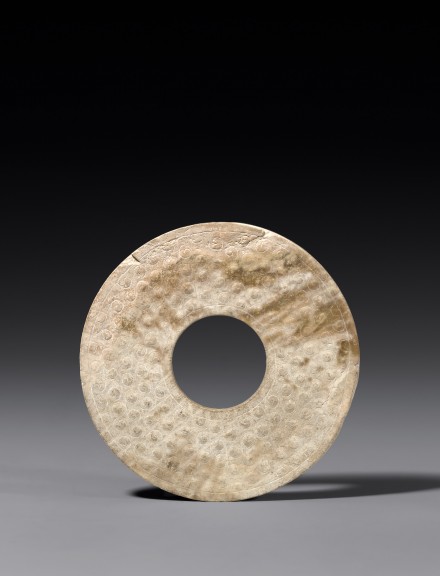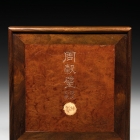J.J. Lally & Co., Oriental Art / New York City, New York
Menu
71.
AN OLIVE GREEN JADE DISC (BI)
Western Han Dynasty (206 B.C. – A.D. 8)
with central aperture approximately the same width as the ring, carved on both sides with oblique rows of incised comma-spirals on shallow bosses in an all over grid pattern defined by shallow lines ground into the surface, bordered by single incised lines near the flat polished edges of the inner and outer rims, the pale olive green jade with degraded surface showing wide areas of cloudy tan color; Chinese wood fitted box with brocade lining and inset burl wood panel bearing the inscription: Zhou Gu bi (周穀璧) Chen shi zhen cang (陳氏珍藏).
Diameter 5 1⁄2 inches (14 cm)
Provenance
From the Collection of Eugene Meyer (1875-1959) and
Agnes E. Meyer (1887-1970)
A similar bi disc carved with comma-spirals discovered at Mancheng, Hebei province, in the tomb of Liu Sheng (r. 154-113 B.C.), the king of the Zhongshan State, is illustrated in the excavation report, Mancheng Han mu fajue baogao (Excavation of the Han Tombs at Man-ch’eng), Beijing, 1980, Vol. II, pl. 211, no. 1 and in a line drawing op. cit., Vol. I, p. 296. Another bi disc of similar form and design discovered in 1977 at Ganquan, Hanjiang, Yangzhou city, Jiangsu province in a late Western Han tomb, now in the collection of the Yangzhou Museum, is illustrated by Xu (ed.) in Han Guangling guo yuqi (Jade Wares of Guangling in Han Dynasty), Beijing, 2003, p. 59, no. 30.
Compare also the similar jade bi disc from a late Warring States period Qin State burial, excavated in 1977 at Gaozhuang, Fengxiang, Shaanxi province, illustrated by Liu (ed.) in Shaanxi chutu Dong Zhou yuqi (Eastern Zhou Dynasty Jades Unearthed in Shaanxi), Beijing, 2006, p. 206, no. GW24.
西漢 菱格穀紋玉璧 徑 14 厘米
出處 邁爾夫婦舊藏
Additional Images (Touch to enlarge)
71.
AN OLIVE GREEN JADE DISC (BI)
Western Han Dynasty (206 B.C. – A.D. 8)
Diameter 5 1⁄2 inches (14 cm)
